A record of the transformation of a fledgling wine
producer into its present state as one of the most respected wine
countries in the world. The theme includes extracts from early
Australian writers on wine, brief accounts of the lives of national
wine figures and the changing language of wine. South Australian
material is generally covered in the theme SA
Story.
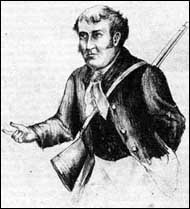 Early
Australians and their writings Early
Australians and their writings
Nineteenth-century Australian wine books reveal a great deal
about our social history. Our pioneer oenographers wrote enthusiastically
of their belief in the future of Australian winegrowing. Many
of them were wine makers, and their books, often drawing on the
writings of European experts, were full of practical advice.
But Australia's soils and climate are different from those of
France and Germany and their recommendations were not always
appropriate.
One of the earliest settlers to
plant grapes in the new colony
was the explorer Gregory Blaxland (1778-1853).
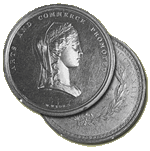 In
1816 he planted vines at "Brush
Farm" in the Parramatta area,
near present-day Eastwood. Blaxland
is recognized as the first exporter
of wine from Australia when in
1822 he sent a pipe of red wine
fortified with brandy to England. In
1816 he planted vines at "Brush
Farm" in the Parramatta area,
near present-day Eastwood. Blaxland
is recognized as the first exporter
of wine from Australia when in
1822 he sent a pipe of red wine
fortified with brandy to England.
For this the Royal Society of
Arts in London awarded him a Silver
Medal in 1823. This success was
followed by a Gold Medal in 1828
for a similar shipment sent in
1827.
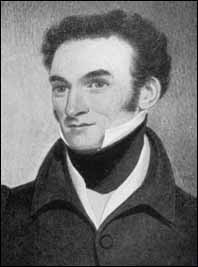 James
Busby (1801-1871), known
as the father of Australian and
New Zealand viticulture and founder
of one of Australia"s best-known
wine regions, the Hunter Valley,
arrived in Australia in 1824.
Having studied viticulture and
winemaking in France, he bought
land in the Hunter Valley named "Kirkton",
later to be developed for winemaking
by his brother-in-law, William
Kelman. While teaching viticulture
at a Liverpool school, Busby
planted a vineyard there but
does not appear to have been
involved in winemaking. Instead
he is noted as being the writer
of Australia"s first wine books,
and importer of vines. James
Busby (1801-1871), known
as the father of Australian and
New Zealand viticulture and founder
of one of Australia"s best-known
wine regions, the Hunter Valley,
arrived in Australia in 1824.
Having studied viticulture and
winemaking in France, he bought
land in the Hunter Valley named "Kirkton",
later to be developed for winemaking
by his brother-in-law, William
Kelman. While teaching viticulture
at a Liverpool school, Busby
planted a vineyard there but
does not appear to have been
involved in winemaking. Instead
he is noted as being the writer
of Australia"s first wine books,
and importer of vines.
A
treatise on the culture of
the vine and the art of making
wine, by James Busby.
Sydney, 1825.
Australia"s first wine book was
written a year after its 24 years
old author arrived in New South
Wales. Based on the ideas of French
writers, it was intended to show "the
respectable portions of the community" how
to produce wine. Busby regarded
viticulture as fitted "to increase
the comforts, and promote the morality
of the lower classes of the Colony".
A
manual of plain directions
for planting and cultivating
vineyards and for making wine
in New
South Wales, by James
Busby. Sydney: 1830. Facsimile
reprint Hunters Hill, N.S.W.
: David Ell Press, 1979.
This work provides detailed instructions
for "smaller settlers". Busby draws
on local experience: his book must
have been of great practical assistance
to its readers. In this extract
he extols the pleasures to be gained
from owning a vineyard.
Catalogue
of vines in the Botanic Garden,
Sydney, introduced into the
colony of New South Wales in
the year 1832, by James
Busby. Sydney, 1842.
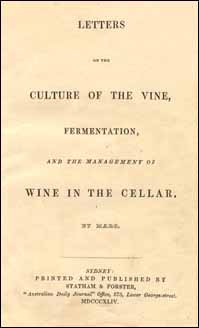 Busby
also compiled our first ampelography.
Originally published, with slightly
different information, in Busby"s
third book, Journal
of a tour through some of the vineyards
of Spain and France (Sydney,
1833) the Catalogue contains lists
of vines collected from the Garden
of the Luxembourg and the Montpelier
Collection. The Sydney Botanic
Garden collection briefly flourished,
but was later neglected and eventually
destroyed. Fortunately, samples
from it were sent to other Australian
colonies including South Australia,
so that the collection was not
completely lost. Busby
also compiled our first ampelography.
Originally published, with slightly
different information, in Busby"s
third book, Journal
of a tour through some of the vineyards
of Spain and France (Sydney,
1833) the Catalogue contains lists
of vines collected from the Garden
of the Luxembourg and the Montpelier
Collection. The Sydney Botanic
Garden collection briefly flourished,
but was later neglected and eventually
destroyed. Fortunately, samples
from it were sent to other Australian
colonies including South Australia,
so that the collection was not
completely lost.
Letters
on the culture of the vine,
fermentation, and the management
of wine in the cellar,
by Maro (i.e. William Macarthur).
Sydney, 1844.
William Macarthur (1800-1882),
son of "merino" John, published
under the signature of "Maro" several
letters of advice on grapegrowing
and winemaking in the newspaper The
Australian, in 1842. Two years
later an expanded version, to which
his own name was added, was published
in book form.
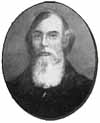 The
vines imported by John, William
and his brother James from France
and Switzerland were planted at
the Macarthur estate, Camden Park,
in 1820: the vineyard was to become
an important source of cuttings
for South Australia and elsewhere.
In 1988 noted English wine writer,
Hugh Johnson, tasted a red wine
made by the Macarthurs some time
between 1825 and 1870, and pronounced
it "sumptuous...of enormous richness".
Macarthur, like his father a man
of strong opinions, was not known
for his kindly attitudes to his
workers-- "Eating grapes amongst
the rows of vines should be absolutely
forbidden", and grape treaders
were expected to work fourteen
to sixteen hours a day. The
vines imported by John, William
and his brother James from France
and Switzerland were planted at
the Macarthur estate, Camden Park,
in 1820: the vineyard was to become
an important source of cuttings
for South Australia and elsewhere.
In 1988 noted English wine writer,
Hugh Johnson, tasted a red wine
made by the Macarthurs some time
between 1825 and 1870, and pronounced
it "sumptuous...of enormous richness".
Macarthur, like his father a man
of strong opinions, was not known
for his kindly attitudes to his
workers-- "Eating grapes amongst
the rows of vines should be absolutely
forbidden", and grape treaders
were expected to work fourteen
to sixteen hours a day.
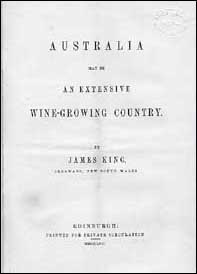 Another
important wine grower of the time
was James King (1800-1857),
of "Irrawang", N.S.W., who arrived
in Sydney in 1827. He first set
up as a merchant before buying
land near Branxton in the Hunter
Valley, planting grapes in 1832
and making his first wine in 1836.
In 1857 he sent a case of samples
of his wine, "of vintage 1844",
to dignitaries of the Duchy of
Nassau, an extensive winegrowing
area near Wiesbaden. The wines
were found to be "excellent. Your
red wine is equal in all respects
to that of Asmanshausen, which
holds the first rank among the
Rhenish red wines". King, along
with his great adversary William
Macarthur, was one of the founders
of the New South Wales Vineyard
Association. This very scarce pamphlet
describes King"s experiences. Another
important wine grower of the time
was James King (1800-1857),
of "Irrawang", N.S.W., who arrived
in Sydney in 1827. He first set
up as a merchant before buying
land near Branxton in the Hunter
Valley, planting grapes in 1832
and making his first wine in 1836.
In 1857 he sent a case of samples
of his wine, "of vintage 1844",
to dignitaries of the Duchy of
Nassau, an extensive winegrowing
area near Wiesbaden. The wines
were found to be "excellent. Your
red wine is equal in all respects
to that of Asmanshausen, which
holds the first rank among the
Rhenish red wines". King, along
with his great adversary William
Macarthur, was one of the founders
of the New South Wales Vineyard
Association. This very scarce pamphlet
describes King"s experiences.
Australia
may be an extensive wine-growing
country, by James King.
Edinburgh: 1857.
Second
annual sale catalogue of 35,230
gallons Dalwood wines to be
sold by auction... May
2nd 1877, on account of Mr.
John Wyndham by Griffiths and
Weaver. Sydney : A.W. Beard,
1877.
One of the few of the early vineyards
still in existence today is "Dalwood",
now Wyndham Estate. George Wyndham arrived
in Sydney in 1827 and the following
year bought 110 acres of land near
Branxton in the Hunter Valley.
By 1832 he had 2 acres of vines,
some of which he had bought from
James Busby, and in 1836 he made
over 7000 litres of wine. Misfortune
came upon him in the 1840s and
he was forced to rent out the property.
This is a catalogue of an 1877
auction of wines by George Wyndham"s
son, John, who toook over the business.
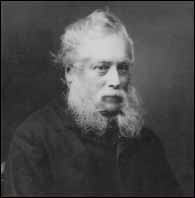 The
other imporant name still in existence
is that of Dr Henry John Lindeman (1811-1881),
who arrived in Sydney from London
in 1840 and settled in Gresford
on the Paterson River where he
set up a medical practice. In 1842
he purchased land he called "Cawarra" and
the following year planted vines.
Unfortunately he lost his winery,
cellars and wine in a fire in 1851.
The winery was rebuilt in 1853
and the vineyard expanded. In 1861
he went into partnership with John
Wyndham of "Dalwood", selling their
wine in Sydney, eventually establishing
his headquarters there in 1870.
In 1872 he expanded his interests,
buying land at Corowa in southern
New South Wales. The
other imporant name still in existence
is that of Dr Henry John Lindeman (1811-1881),
who arrived in Sydney from London
in 1840 and settled in Gresford
on the Paterson River where he
set up a medical practice. In 1842
he purchased land he called "Cawarra" and
the following year planted vines.
Unfortunately he lost his winery,
cellars and wine in a fire in 1851.
The winery was rebuilt in 1853
and the vineyard expanded. In 1861
he went into partnership with John
Wyndham of "Dalwood", selling their
wine in Sydney, eventually establishing
his headquarters there in 1870.
In 1872 he expanded his interests,
buying land at Corowa in southern
New South Wales.
The arrival in Victoria of Charles
Joseph La Trobe in 1839 with his
Swiss wife was soon followed by
a number of winemakers from Neuchatel,
Switzerland, names like Belperroud
and Pettavel, and De Castella.
Amongst the earliest areas to
be planted in Victoria was that
of the Geelong region.
Essays
on the vine with instructions
for its cultivation in Australia
and how to make wine being
a compilation of A concise
and practical treatise on the
cultivation of the vine in
the colony of Victoria,
by John Belperroud, and
A concise and practical treatise
on the cultivation of the vine
in the colony of Victoria,
by D.L.
Pettavel. Geelong :
Heath and Cordell, 1859.
These two essays were awarded
prizes by the Geelong and Western
District Agricultural and Horticultural
Society. Belperroud"s essay includes
a section on existing vineyards
in the Geelong area.
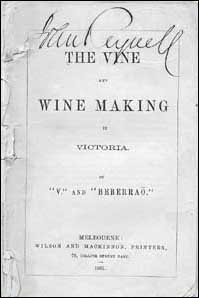 The
vine and wine making in Victoria,
by "V " and "Beberrao". Melbourne:
Wilson and Mackinnon, printers,
1861. The
vine and wine making in Victoria,
by "V " and "Beberrao". Melbourne:
Wilson and Mackinnon, printers,
1861.
This small pamphlet is largely
a collection of letters to the
editor of the Melbourne newspaper,The
Argus, regarding the means
of winemaking suitable for use
in the colony of Victoria. Included
is a resumé of the possible
grape varieties and their ratings.
As John Reynell"s personal copy,
it is well-used with several hand-written
notes, though lacking several pages.
Wine-growing
in Australia, and the teachings
of modern writers on vine-culture
and wine-making, by
Dr .Alexander Kelly. Adelaide:
E.S. Wigg, 1867.
Dr.
Alexander Charles Kelly (1811-1877),
a wine-growing doctor, planted
a vineyard in the early 1840s
near Morphett Vale, which he
named 'Trinity'. He later became
a founder of the Tintara Vineyard
Company at McLaren Vale, eventually
to be taken over by Thomas
Hardy. Kelly believed in the
medicinal value of wine. This
work, together with his The
vine in Australia, is a
thorough and intelligent presentation
of theory and practice, and
was of inestimable value to
the vignerons of the time.
Kelly was an unsuccessful entrant
for the prize by the Geelong
and Western District Agricultural
and Horticultural Society which
was won by Belperroud and Pettavel.
The
vine in Australia,
by Dr. Alexander Kelly. Melbourne
: Sands, Kenny, 1861.
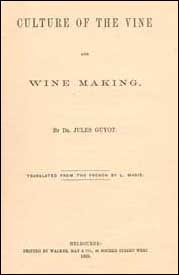 Culture
of the vine and wine making,
by Dr. Jules Guyot. Melbourne,
1865. Culture
of the vine and wine making,
by Dr. Jules Guyot. Melbourne,
1865.
This work was originally published
in French in 1860. Guyot was a
noted French viticulturalist and
a great advocate of cane pruning.
An important method of pruning
is named after him. This copy belonged
to John Reynell and has page after
page underlined and marginally
annotated by him. From the great
use made of it one can see the
book as the gospel it once was.
Hubert
de Castella (1825-1907),
founder of St Hubert"s vineyard
in Victoria"s Lilydale area,
was the most lyrical and entertaining
of Australia"s nineteenth-century
wine writers. A naturalised
migrant from Switzerland, he
was an optimist, an enthusiast
for Australia, for wine, and
for the "contentment" of the
wine-drinking Australian worker.
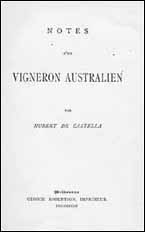 Notes
d'un vigneron Australien,
par Hubert de Castella. Melbourne:
G. Robertson, 1882. Translated
by C.B. Thornton-Smith as Notes
of an Australian vine grower.
Melbourne : Mast Gully Press,
1979. This work, intended to
interest the French public
in Australia and the Australian
wine industry, is the more
realistic of his two books:
it relates financial hardships
and other problems, including
distastrous choices of grape
varieties and viticultural
methods in the unknown Australian
climate. Notes
d'un vigneron Australien,
par Hubert de Castella. Melbourne:
G. Robertson, 1882. Translated
by C.B. Thornton-Smith as Notes
of an Australian vine grower.
Melbourne : Mast Gully Press,
1979. This work, intended to
interest the French public
in Australia and the Australian
wine industry, is the more
realistic of his two books:
it relates financial hardships
and other problems, including
distastrous choices of grape
varieties and viticultural
methods in the unknown Australian
climate.
John
Bull"s vineyard, by
Hubert de Castella. Melbourne,
1886.
These are inspiring books, running
over with rich bonhomie, loving
detail and sound advice.
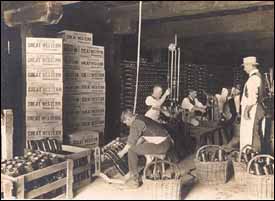 Views
of Hans Irvine's Great Western
vineyards and champagne cellars
: Victoria, Australia.
1895. Views
of Hans Irvine's Great Western
vineyards and champagne cellars
: Victoria, Australia.
1895.
In 1888 the Great Western winery
founded by Joseph Best was sold
to Hans Irvine (1856-1922),
a Ballarat businessman and politician.
Irvine was intent upon making a
sparkling wine comparable with
that of French Champagne, and to
achieve this he attained the assistance
of Charles Pierlot, a winemaker
from the House of Pommery. Together
they developed the venture into
a successful, award-winning sparkling
wine business, using the grape
variety known as Irvine"s White
(Ondenc) as well as the traditional
Pinots. On Irvine"s retirement
in 1918 the enterprise was taken
over by Seppelts, who still continue
the Great Western tradition today.
The
Diary of Arthur Nicholson.
Nicholson was a wine buyer in
Melbourne for P.B. Burgoyne and
Co. from 1888 to 1903. His "diary" is
a record of his visits to more
than 180 winegrowers throughout
Victoria, New South Wales and South
Australia. |


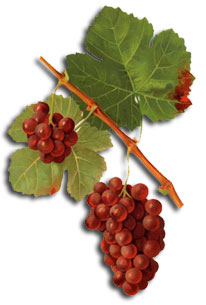
 Early
Australians and their writings
Early
Australians and their writings In
1816 he planted vines at "Brush
Farm" in the Parramatta area,
near present-day Eastwood. Blaxland
is recognized as the first exporter
of wine from Australia when in
1822 he sent a pipe of red wine
fortified with brandy to England.
In
1816 he planted vines at "Brush
Farm" in the Parramatta area,
near present-day Eastwood. Blaxland
is recognized as the first exporter
of wine from Australia when in
1822 he sent a pipe of red wine
fortified with brandy to England.
 James
Busby (1801-1871), known
as the father of Australian and
New Zealand viticulture and founder
of one of Australia"s best-known
wine regions, the Hunter Valley,
arrived in Australia in 1824.
Having studied viticulture and
winemaking in France, he bought
land in the Hunter Valley named "
James
Busby (1801-1871), known
as the father of Australian and
New Zealand viticulture and founder
of one of Australia"s best-known
wine regions, the Hunter Valley,
arrived in Australia in 1824.
Having studied viticulture and
winemaking in France, he bought
land in the Hunter Valley named " Busby
also compiled our first ampelography.
Originally published, with slightly
different information, in Busby"s
third book,
Busby
also compiled our first ampelography.
Originally published, with slightly
different information, in Busby"s
third book,  The
vines imported by John, William
and his brother James from France
and Switzerland were planted at
the Macarthur estate, Camden Park,
in 1820: the vineyard was to become
an important source of cuttings
for South Australia and elsewhere.
In 1988 noted English wine writer,
Hugh Johnson, tasted a red wine
made by the Macarthurs some time
between 1825 and 1870, and pronounced
it "sumptuous...of enormous richness".
Macarthur, like his father a man
of strong opinions, was not known
for his kindly attitudes to his
workers-- "Eating grapes amongst
the rows of vines should be absolutely
forbidden", and grape treaders
were expected to work fourteen
to sixteen hours a day.
The
vines imported by John, William
and his brother James from France
and Switzerland were planted at
the Macarthur estate, Camden Park,
in 1820: the vineyard was to become
an important source of cuttings
for South Australia and elsewhere.
In 1988 noted English wine writer,
Hugh Johnson, tasted a red wine
made by the Macarthurs some time
between 1825 and 1870, and pronounced
it "sumptuous...of enormous richness".
Macarthur, like his father a man
of strong opinions, was not known
for his kindly attitudes to his
workers-- "Eating grapes amongst
the rows of vines should be absolutely
forbidden", and grape treaders
were expected to work fourteen
to sixteen hours a day.
 Another
important wine grower of the time
was James King (1800-1857),
of "Irrawang", N.S.W., who arrived
in Sydney in 1827. He first set
up as a merchant before buying
land near Branxton in the Hunter
Valley, planting grapes in 1832
and making his first wine in 1836.
In 1857 he sent a case of samples
of his wine, "of vintage 1844",
to dignitaries of the Duchy of
Nassau, an extensive winegrowing
area near Wiesbaden. The wines
were found to be "excellent. Your
red wine is equal in all respects
to that of Asmanshausen, which
holds the first rank among the
Rhenish red wines". King, along
with his great adversary William
Macarthur, was one of the founders
of the New South Wales Vineyard
Association. This very scarce pamphlet
describes King"s experiences.
Another
important wine grower of the time
was James King (1800-1857),
of "Irrawang", N.S.W., who arrived
in Sydney in 1827. He first set
up as a merchant before buying
land near Branxton in the Hunter
Valley, planting grapes in 1832
and making his first wine in 1836.
In 1857 he sent a case of samples
of his wine, "of vintage 1844",
to dignitaries of the Duchy of
Nassau, an extensive winegrowing
area near Wiesbaden. The wines
were found to be "excellent. Your
red wine is equal in all respects
to that of Asmanshausen, which
holds the first rank among the
Rhenish red wines". King, along
with his great adversary William
Macarthur, was one of the founders
of the New South Wales Vineyard
Association. This very scarce pamphlet
describes King"s experiences.
 The
other imporant name still in existence
is that of Dr Henry John Lindeman (1811-1881),
who arrived in Sydney from London
in 1840 and settled in Gresford
on the Paterson River where he
set up a medical practice. In 1842
he purchased land he called "Cawarra" and
the following year planted vines.
Unfortunately he lost his winery,
cellars and wine in a fire in 1851.
The winery was rebuilt in 1853
and the vineyard expanded. In 1861
he went into partnership with John
Wyndham of "Dalwood", selling their
wine in Sydney, eventually establishing
his headquarters there in 1870.
In 1872 he expanded his interests,
buying land at Corowa in southern
New South Wales.
The
other imporant name still in existence
is that of Dr Henry John Lindeman (1811-1881),
who arrived in Sydney from London
in 1840 and settled in Gresford
on the Paterson River where he
set up a medical practice. In 1842
he purchased land he called "Cawarra" and
the following year planted vines.
Unfortunately he lost his winery,
cellars and wine in a fire in 1851.
The winery was rebuilt in 1853
and the vineyard expanded. In 1861
he went into partnership with John
Wyndham of "Dalwood", selling their
wine in Sydney, eventually establishing
his headquarters there in 1870.
In 1872 he expanded his interests,
buying land at Corowa in southern
New South Wales.
 The
vine and wine making in Victoria
The
vine and wine making in Victoria

